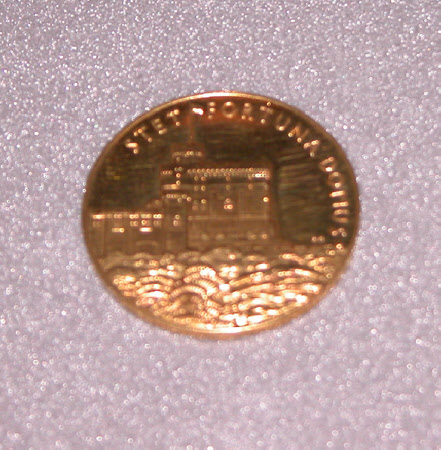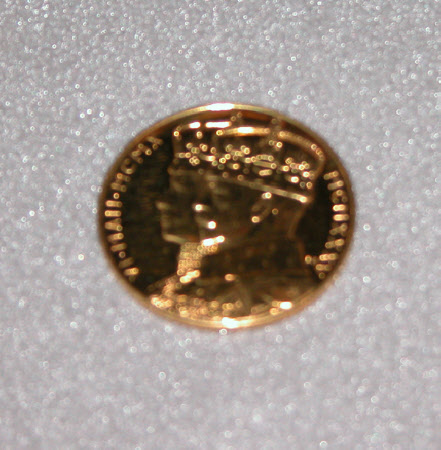Silver Jubilee Medal for King George V
Percy Metcalfe
Category
Coins and medals
Date
1935
Materials
Gold
Measurements
315 mm (Diameter)
Place of origin
United Kingdom
Order this imageCollection
Anglesey Abbey, Cambridgeshire
NT 517319
Summary
Gold, Silver Jubilee Medal for King George V, designed by Percy Metcalfe (1895-1970, struck Royal Mint, 1935. A gold portrait medal commemorating the Silver Jubilee of King George V in 1935, by Percy Metcalfe. The obverse with conjoined crowned busts of King George V (1865-1936) and Queen Mary (1867-1953) facing left; the legend 'VI. MAII. MCMX/MCMXXXV' translates as: 6 May 1910 1935; the artist’s initials 'PM' in field to right of King George. The reverse has a view of Windsor Castle; above it is the legend 'STET FORTUNA DOMUS' which translates as ‘May Fortune long remain within the house’. The artist’s initials 'PM' to right in the field.
Full description
The celebrations for the Silver Jubilee of King George V, marking the first 25 years of his reign, were the first to have been held for a monarch of the United Kingdom. Great effort was put into ensuring that the ceremonies, on 6 May 1935, went smoothly. On a beautiful day, the King and Queen attended a thanksgiving service at St. Paul’s Cathedral, with thousands of people lining the Mall and other parts of the route of the royal procession. The medal was the official medal for the Jubilee. It was struck by the Royal Mint in two sizes, the large size (5.7 cm diameter) in gold and silver, with a matt finish. The smaller size was struck in gold, silver and bronze. 247 examples of the small gold were sold, at a price of 12 guineas (£12.60) The legend on the reverse, wishing continued long life to the House of Windsor, is based on a phrase in Virgil’s Georgics, iv. 208. It is also the motto of Harrow School. Percy Metcalfe made many designs for coins and medals for the Royal Mint between 1924 and 1948. Born in Leeds, he studied at the Royal College of Art under Francis Derwent Wood, and worked as a sculptor and designer. He is best known as a designer of coins and medals in a distinctive modernist Art Deco style. In 1924 he won a competition organised by the Goldsmiths Company for a medal commemorating the British Empire Exhibition, which was used as the official award medal for exhibitors. In 1928 he designed the first coinage for the Irish Free State, a famous set of eight coins with iconic designs of animals, which became known as the ‘Barnyard Collection’. Metcalfe also designed the harp emblem for the Great Seal of the Irish Free State and, in 1940, the George Cross, the highest award for civilian gallantry. Among the medals at Anglesey Abbey, Metcalfe also designed the official medal for the Coronation of King George VI and Queen Elizabeth in 1937 (NT 517321). Jeremy Warren 2019
Provenance
Urban Huttleston Rogers Broughton, 1st Lord Fairhaven (1896-1966); bequeathed to the National Trust in 1966 by Lord Fairhaven with the house and the rest of the contents.
Credit line
Anglesey Abbey, The Fairhaven Collection (The National Trust)
Marks and inscriptions
Obverse, legend: VI. MAII. MCMX/MCMXXXV Obverse, to right of George V: PM Reverse, legend: STET FORTUNA DOMUS Reverse, towards right: PM
Makers and roles
Percy Metcalfe, designer The Royal Mint, manufacturer
References
Wollaston 1978: Henry Wollaston, The Commemorative Collectors Guide to British Official Medals for Coronations and Jubilees, Nottingham 1978, p. 90. Brown 1995: Laurence Brown, A Catalogue of British Historical Medals 1760-1960. Volume III. The Accession of Edward VII to 1960, London 1995, p. 144, no. 4249. Eimer 2010: Christopher Eimer, British Commemorative Medals and their Values, London 2010, p. 265, no. 2029, Pl. 226. Whittlestone and Ewing 2009: Andrew Whittlestone and Michael Ewing, Royal Commemorative Medals 1837-1977. Vol. 7, King George the Sixth, 1936-1952, Llanfyllin 2009, p. 121, no. 5668.

